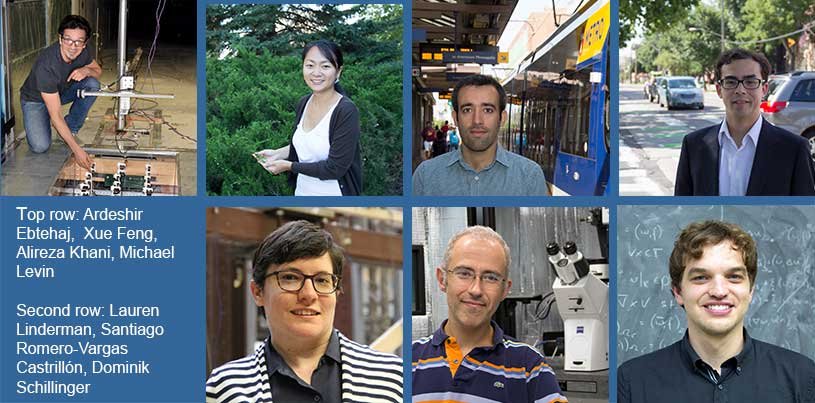Assistant Professors Promise Bright Future for CEGE

The Department of Civil, Environmental, and Geo- Engineering (CEGE) has a long history built on a deep foundation of distinguished and internationally recognized researchers. We are proud that figures like Theodore Galambos, known as the father of LFRD, and Karl Smith, who advanced the field of engineering education, are CEGE faculty. And proud that five faculty are members of the National Academy of Engineering: Steven Crouch, Peter Cundall, Emmanuel Detournay, Charles Fairhurst, and Theodore Galambos. But it takes continual renewal to maintain a vibrant program of teaching, research, and service. Over the past five years, several bright, promising scholar-researchers have joined the CEGE faculty. These assistant professors (shown in alphabetical order) point to a promising future for CEGE.
Ardeshir Ebtehaj
(Ph.D., 2013, Civil Engineering, University of Minnesota) Ebtehaj’s research area is environmental engineering and water resources. He works on problems related to physical and data science hydrology, satellite hydrology, remote sensing, land-atmosphere interactions, climate intelligence, and big earth-data analytics.
“My research is focused on land-atmosphere remote sensing and interactions. The goal is to better understand the global water and energy cycle through satellite remote sensing and to develop technologies for sustainable water conservation by expanding our knowledge in experimental hydrology.”
Read more about Ardeshir Ebtehaj
Ebtehaj’s research group website
Xue Feng
(Ph.D., 2015, Civil and Environmental Engineering, Duke University) studies the feedback between vegetation and the hydrological cycle across a range of temporal and spatial scales. She is interested in how the interactions between plants and water inform our understanding of soil water and carbon budgeting, ecosystem health and functioning (and the response to climate extremes), as well as water management decisions around irrigation, salinization, and pollution control.
“I study how plants mediate the water cycle. Plants help accelerate the movement of water in the ground and back to the atmosphere, so where and when plants end up growing, and how much, can have huge implications for how we think about water resources management.”
Alireza Khani
(Ph.D., 2013, Civil Engineering, University of Arizona) conducts research on transportation network modeling, transportation user behavior, public transit planning and operations, and application of big data in transportation.
“Transportation systems are transitioning to a new era with the shared use of vehicles, and soon with driverless vehicles. But cities need high capacity and reliable transit systems to increase mobility and reduce congestion and environmental footprints. My research is focused on modeling, simulation and optimization of transit systems.”
Read more about Alireza Khani’s research
Khani’s research group website
Michael Levin
(Ph.D., 2017, Civil Engineering, University of Texas at Austin) conducts research on connected autonomous vehicles, traffic flow theory, and intelligent transportation systems.
“Autonomous vehicles have the potential to revolutionize how we use our ground transportation systems. My research goals are to model how connected and autonomous vehicles affect traffic flow and traveler behaviors, and use these models to optimize traffic controls and policies for these developing technologies.”
Levin’s research group website
Lauren Linderman
(Ph.D., 2013, Civil Engineering, University of Illinois at Urbana-Champaign) studies cyber-physical systems in order to improve the long-term performance of structures or limit their response during transient events, such as earthquakes.
“I received significant start-up funds from the department and the University, which jump-started my experimental program. The shake table is a signature piece of equipment central to my research group. It will allow us to develop new structural control solutions to limit dynamic response. Additionally, the accelerometers and associated data acquisition equipment purchased with those funds have been essential for understanding system behavior and exploring monitoring techniques for bridges and buildings.”
Linderman's research group website
Santiago Romero-Vargas Castrillón
(Ph.D., 2012, Chemical Engineering, Princeton University). Romero-Vargas Castrillón’s research involves environmental nanotechnology; environmental colloid and surface science; membrane-based processes for water production; and molecular simulation.
“Water scarcity is one of the central problems of our time. Millions of people are affected by difficult or intermittent access to water, a problem that will be aggravated by population growth, industrialization, urbanization, and climate change. My research is focused on developing new materials and processes for water treatment, with a particular emphasis on membrane-based processes.”
Romero-Vargas Castrillón's Environmental Physical Chemistry research group website
Dominik Schillinger
(Ph.D., 2012, Computational Mechanics, Technische Universität München). Schillinger’s research area is computational mechanics, especially the development and implementation of novel discretization techniques for the analysis of solids, structures, and fluids that overcome limitations of today's standard numerical tools.
“The generous start-up funds granted by the department and the college have been fundamental for creating a successful research program, in which funding agencies such as the National Science Foundation have started to invest. In the first two years, these funds were particularly important. Before being supported by external grants, I was able to attract top graduate students, who transformed my research ideas into results. And I could participate in international conferences, where I presented these results to build a reputation as an active high-quality researcher.”